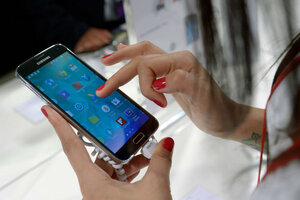Hinge's redesign bets that Millennials are looking for deeper relationships
Hinge, the dating app, has a new look. The 'story' format is intended to spark deeper connections between users, with a view to forming long-term relationships. The company hopes this will become the 'new normal' for dating apps.

Hinge, an dating app, is doubling down on its efforts to find genuine relationships for its users. The service's new look launched on Tuesday.
Manu Fernandez/AP/File
Hinge has “swiped left” on a culture of dating apps that they say fail to foster meaningful connections. Instead, they’re doubling down on efforts to help their users find genuine relationships.
The company, once a peer of Tinder, OkCupid, and Happn, has been pursuing a new look for the past nine months. Following user surveys and various pilots, the new service launched Tuesday, introducing a “story” interface Hinge says sparks five times more conversations than in the past.
Some Millennials – the target market of the proliferation of dating apps – say they aren’t actually looking for relationships, but there may be many more who are. Hinge hopes to appeal to that demographic, and possibly even change the conversation about dating apps.
“With the relaunch we hope we can pave the way for a new normal in dating culture that treats people with dignity and helps those bold enough to seek real relationships find what they’re looking for,” Karen Fein, Hinge’s vice president of marketing, tells The Christian Science Monitor in an email, echoing a Medium article by Hinge co-founder and CEO Justin McLeod.
The company’s reincarnation was spurred by a 2015 Vanity Fair story that came down hard on dating apps, saying they encourage a culture that has destroyed romance, dating, and relationships. The article prompted Mr. McLeod to reflect that, “When I started Hinge as the first social-media-integrated dating service in 2011, this was certainly not the world I imagined.”
Soon afterwards, the company launched HingeLabs, a “user-led research division,” and “surveyed [their] users extensively about their experience with swiping apps,” Ms. Fein says. They found that, though Hinge was considered the most relationship-oriented of the available apps, 70 percent of users wanted a deeper experience.
“So that’s what we set out to build: an app tailor-made for people who want more than swiping games,” Fein explains.
In doing so, the company in some ways followed in the footsteps of dating sites. The online dating service eHarmony, which now boasts more than two million marriages, emphasizes long-term matches. As Marylyn Warren, wife of the co-founder and former CEO, told The Christian Science Monitor in 2005:
"Our whole focus is on putting people together, making compatible matches that have the possibility of the long term. If you want a date for Saturday night, we probably are just not the place to come."
Millennials are less likely to be found on these sites, thanks to what McLeod described as an unwillingness “to join the Baby Boomer generation on expensive, old-fashioned websites.” Dating apps, meanwhile, have become a mainstay of less serious relationships. Hinge hopes their new approach will help bridge that gap.
The pattern observed by HingeLabs is a change in the way society typically thinks about Millennials – but other studies support the finding that they want serious connections. In a survey conducted by the dating site Match, 59 percent of men and 49 percent of women believe in love at first sight. And 53 percent of never-married adults say they would like to marry someday, while a further 32 percent are unsure, a 2014 survey by the Pew Research Group found.
So what’s holding serious relationships back? Some adults are not ready to settle down, Pew finds, while others say they are not in a good position financially. Seventy-eight percent of women said that finding a spouse or partner with a steady job would be very important, which is challenging given changes in the labor market that are limiting young men’s job prospects, according to Pew.
But much of the struggle is also finding the right person. Hinge’s new approach could be a way to address that problem, says Lori Gottlieb, a couples therapist and the author of “Marry Him: The Case for Settling for Mr. Good Enough.”
“It sounds like what Hinge is trying to do is say, 'You need to slow down…you need to have some investment in contacting this person,'” she tells the Monitor in a phone interview. In Hinge’s new interface, users interested in connecting with someone else "like" or comment on a piece of their profile, whether a photo or a response to one of Hinge’s "icebreaker" questions. That person then decides whether he or she is interested in pursuing a conversation.
Ms. Gottlieb explains that traditional dating apps are “a great way to meet people, because people are so busy,” and it’s hard to know where single people are, but that the apps can foster a tendency to treat dating like shopping. With too many choices, the whole experience can become overwhelming, she says. As a result, “people are kind of over the whole Tinder model.”
Hinge’s focus on deeper connections may help combat the “pervasive sense of loneliness and isolation” that other dating apps don’t address, Gottlieb says. And the $7 fee to use the service may help create a community of people looking for something more substantial. (An estimated 42 percent of Tinder users are not actually single, contributing to its limited effectiveness at connecting people).
But the Hinge app’s success will ultimately be judged by how well it gets people to connect in person, Gottlieb concludes. “You really can’t know anything about a person until you’re face to face with them,” she says, giving the example of young people she treats who develop relationships via text, only to discover that in person, “it’s a completely different dynamic.”

